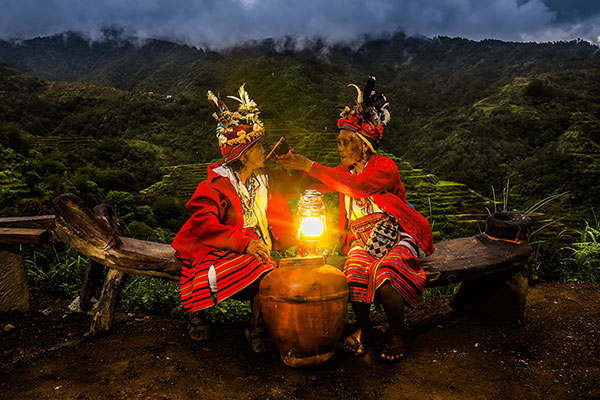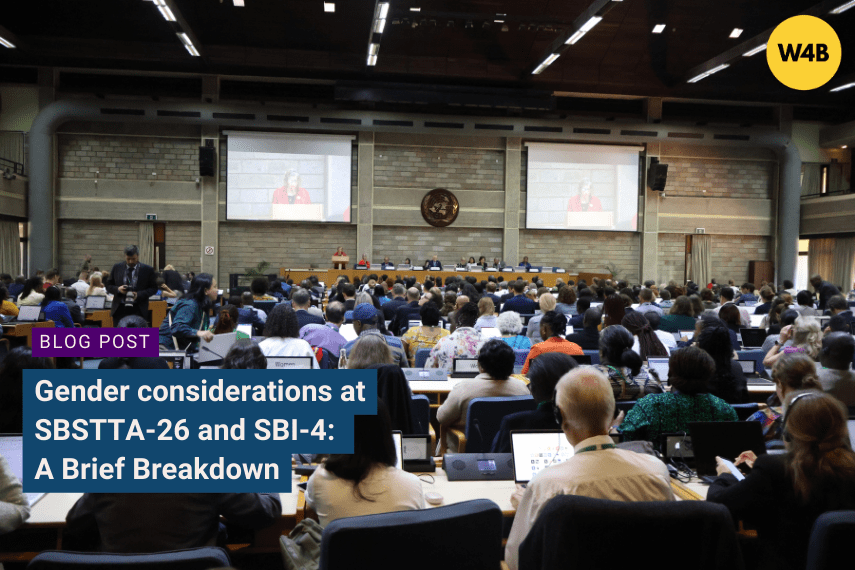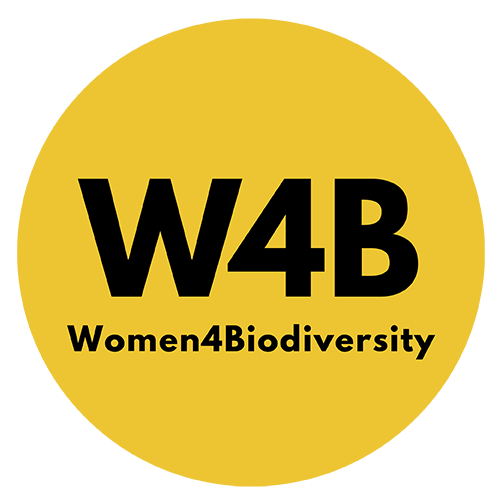By Alejandra Duarte and Meenal Tatpati, Policy Team at Women4Biodiversity
The 26th meeting of the Subsidiary Body on Scientific, Technical and Technological Advice (SBSTTA-26) and the 4th meeting of the Subsidiary Body on Implementation (SBI-4) took place from 13 – 29 May 2024 in Nairobi, Kenya. During the meetings, the focus was on laying the groundwork for the effective implementation of the Global Biodiversity Framework (GBF), which includes 23 Targets for 2030 and Four long-term Goals for 2050. SBSTTA 26 concentrated on providing the scientific and technical foundation in topics such as monitoring, synthetic biology, risk assessment and risk management, living modified organisms, marine and coastal and health; while SBI 4 focused on essential aspects such as providing financial resources, and establishing mechanisms for reviewing implementation, reporting, and monitoring. Apart from this, several aspects of the CBD, including Marine and Coastal Biodiversity as well as Biodiveristy and Health were also discussed.
Below is a brief analysis of how gender considerations were taken into account in the some of these agendas and what needs to be considered way forward.
Monitoring Framework and Gender
In the context of discussions pertaining to the monitoring framework, the Parties, in their final recommendation[1], called upon the Secretariat of the CBD to furnish a comprehensive list of component and complementary indicators as adopted in Decision 15/5, but excluded due to non-conformance with the stipulated criteria. Additionally, the Parties acknowledged the ongoing process led by Women4Biodiversity and UNEP-WCMC to develop an indicator for the national implementation of the Gender Plan of Action. This indicator[2] is deemed critical in supporting the realization of the 18 intended actions to be initiated and executed by Parties in furtherance of the gender plan of action, thus advancing gender-responsive monitoring of the KM-GBF. Notably, the indicator is presently undergoing a review process by the Parties and key stakeholders to be ready for integration by the Sixteenth Conference of the Parties of the CBD (COP 16). It represents a significant stride in promoting gender inclusivity in biodiversity conservation and management. However, an important complementary indicator included by the COP 15 within the monitoring framework was the proportion of countries with systems to track and make public allocations for gender equality and women’s empowerment[3]. This indicator has not been included in the complementary indicators to measure progress towards Target 23 in the final recommendations. This is crucial to encourage national governments to develop appropriate budget tracking and monitoring systems and commit to sharing information about allocations made for gender equality available to the public.
Marine and Coastal Biodiversity and Gender
Marine and Coastal Biodiversity addressed two parts, one on further work on ecologically or biologically significant marine areas, and the other one on conservation and sustainable use of marine and coastal biodiversity. Further work on Ecologically or Biologically Significant Marine Areas (EBSAs), the outcomes of the expert workshops were welcomed and the extension of the mandate of the advisory group, supported. In the final recommendation, SBSTTA recommends, among other, to facilitate the participation in the workshops of experts from Indigenous Peoples and Local Communities (IPLCs), women and youth organizations, and the use of traditional knowledge.
Regarding conservation and sustainable use of marine and coastal biodiversity, many supported the review and analysis of the work programmes, including on island biodiversity, and highlighted the need for cooperation with the Agreement on the conservation and sustainable use of marine biodiversity of areas beyond national jurisdiction (BBNJ Agreement). On this topic, SBSTTA recommends, among others, to facilitate the participation in the workshops of experts from Indigenous Peoples and Local Communities (IPs and LCs), women and youth organizations, and the use of traditional knowledge, and to continue facilitating capacity-building and partnership activities, including through the Sustainable Ocean Initiative, with the participation of IPLCs, women, and youth, to support GBF implementation, while all the Annex is on brackets. Although recommendations have been included that request Parties to facilitate the participation and active involvement of women in workshops and capacity building, it is imperative that the policies adopted incorporate a human rights and gender-based approach, so that implementation can ensure the full and effective participation of all groups; in this line it is urgent to ensure that businesses, large and transnational companies and financial institutions related to and dependent on marine, coastal and inland biodiversity reduce their negative impacts on biodiversity and carry out environmental and social impact assessments and transparently disclose risks, dependencies and impacts on biodiversity along their operations, supply and value chains and portfolios.

Biodiversity and Health and Gender
Regarding Biodiversity and Health, SBSTTA recommends to encourage Parties, in accordance with national circumstances and priorities, and on a voluntary basis, to: recognize the need to urgently address the drivers of biodiversity loss to reduce risks to health; and integrate biodiversity and health interlinkages into biodiversity related policies, programmes, or accounts and, if appropriate, in their national biodiversity strategies and action plans (NBSAPs). While Annex I contains the Draft Global Action Plan on Biodiversity and Health, it remains bracketed. It is important to assess the interlinkages between biodiversity and health. It needs to take into account a comprehensive understanding of well-being, including sexual and reproductive health, which can be defined as a person’s right to a healthy body. Health, on the other hand, is a “state of complete physical, mental and social well-being and not merely the absence of disease or infirmity”. Hence, all health dimensions must be addressed in the Global Action Plan on Biodiversity and Health. Human health depends upon ecosystem products and services, and biodiversity loss can have significant direct human health impacts. Many drivers of this crisis (land-use change, habitat loss, overexploitation, pollution, invasive species and climate change) is reducing the ability of biodiversity and ecosystems to provide essential life-sustaining services, leading to negative outcomes for health and well-being, and increasing the risk from infectious diseases. Likewise, the chemicals present in different daily products have a great impact on our health, the use of contraceptive hormones and veterinary growth hormones affects both male and female human reproduction, and have been linked to prostate cancer, neurological, endocrinological, thyroid, obesity, and cardiovascular problems.
Final observations
While SBI-4 did reiterate that the provision and mobilization of resources from all sources for implementation of the Framework should follow a human rights-based and gender-responsive approach and recognised that, despite the important role and contributions of indigenous peoples and local communities, people of African descent, and women and youth representatives to the implementation of the Framework, they receive relatively little finance and often lack direct access to biodiversity finance, these recommendations pertaining to resource mobilisation remain in brackets. This means that considerable consensus decision-making will have to be adopted at COP16.
Furthermore, there is no specific allocation of resources to ensure the operationalisation of the Gender Plan of Action or the full and effective participation and representation women and girls towards the goals of the CBD. A crucial aspect of this was to ensure that adequate support was provided to parties to also enable the appointment of Gender Focal Points and adequate resources for women’s groups and organisations to participate in CBD processes. This has not been considered at SBI.
While there have been certain positive developments, there still remains a lot to be done for the gender responsive implementation of the KM-GBF including mainstreaming gender across all Targets and Goals of the KMGBF ensuring that disaggregated data is collected on gender while implementing all the Targets.
📖 Read the policy recommendations published by Women4Biodiversity during SBSTTA-26 here.

📖 Read all about Women4Biodiversity’s engagements at SBSTTA-26 and SBI-4 here.
Sources
[1] Monitoring framework for the Kunming-Montreal Global Biodiversity Framework (cbd.int)
[2] Factsheet – Indicators for the Post 2020 Global Biodiversity Framework | Indicator Repository (gbf-indicators.org)
[3] Metadata-05-0c-01.pdf (un.org)
About the authors

Alejandra’s passion for nature and all its inhabitants led to a lifelong commitment to biodiversity conservation. She actively advocates for the inclusion of women and youth in local and international biodiversity policies, the recognition of their rights, their contributions and the effective participation of these actors in policies, in line with this work she is part of the Global Youth Biodiversity Network, and the Women’s Caucus. She holds a BA in Agroforestry Engineering and a MA in Forest Resources Conservation with a focus on Forest Ecology. She has conducted research in tropical dry forests and montane cloud forests. She is also a member of the IUCN Commission on Environmental, Economic and Social Policy and Issues and the World Commission on Protected Areas.

Meenal is a researcher with a keen interest in the jurisprudence of forests, the role indigenous and local communities play in their conservation and laws and policies that affect their democratic governance. Through this work she has developed a keen interest in understanding the worldviews of Indigenous Peoples and Local Communities leading to the documentation of the worldviews of the Dongria Kondh community and Raika pastoralist women in India. She has also actively engaged in advocacy around Protected Area governance, management and expansion issues. She coordinated the national-level Community Forest Rights Learning and Advocacy Process from 2014-2017 in India; and of the Rangelands and Pastoralism Territories of Life Group within the Indigenous Peoples and Community Conserved Territories and Areas (ICCA) Consortium. She is a member of the IUCN WCPA and WCEL, and Kalpavriksh. Meenal holds a LLB in Law and an MSc degree in Environmental Sciences.


